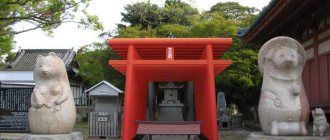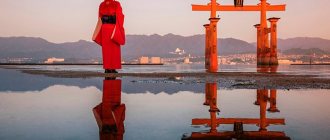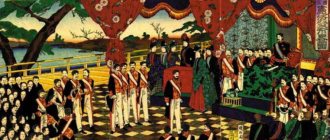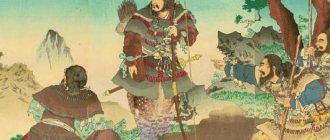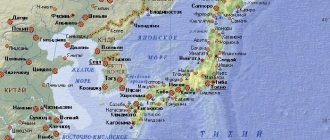Shintoism is the essence of religion - briefly.
In simple words, Shintoism is not exactly a religion in the classical sense of the term, but rather a philosophy, idea and culture based on religious beliefs. In Shinto there are no specific canonical sacred texts, no formal prayers and no obligatory rituals. Instead, worship options vary greatly depending on the shrine and deity. Very often in Shinto it is customary to worship the spirits of ancestors, who, according to beliefs, constantly surround us. From the above we can conclude that Shintoism is a very liberal religion aimed at creating the common good and harmony with nature.
Origin of religion. Where did Shintoism originate?
Unlike many other religions, Shintoism does not have a founder or a specific point of origin in time. The peoples of ancient Japan long practiced animistic beliefs, worshiping divine ancestors and communicating with the spirit world through shamans. Many of these practices migrated to the so-called first recognized religion - Shinto (Shintoism). This happened during the Yayoi culture from about 300 BC to 300 AD. It was during this period that certain natural phenomena and geographical features were given the names of various deities.
In Shinto beliefs, supernatural powers and entities are known as Kami. They control nature in all its forms and live in places of great natural beauty. In addition to the conventionally benevolent spirits “Kami”, Shintoism contains evil entities - demons or “They” which are mostly invisible and can live in different places. Some of them are represented as giants with horns and three eyes. The power of "They" is usually temporary, and they do not represent an inherent force of evil. As a rule, in order to calm them down, it is necessary to perform a certain ritual.
What is the religion in Japan?
Scientists cannot clearly understand what role Shinto played in the formation of the state, and what significance Buddhism had in this matter. At one time, a noisy controversy erupted around this issue. Therefore, currently in Japan there is so-called religious syncretism - a combination of different faiths.
The majority of the population considers themselves either Buddhists or Shintoists, or both. At the birth of a child, they can perform rituals in a Shinto shrine, a wedding ceremony in a Buddhist one, and read the “Tibetan Book of the Dead” over the body of the deceased.
Over time, the boundaries of religions are erased so much that Shinto-Buddhist teachings appear, for example, Shingon-shu, Shugendo, the difference between which may seem simply illusory to ordinary people.
Basic concepts and principles in Shintoism.
- Purity. Physical purity, spiritual purity and avoidance of destruction;
- Physical well-being;
- Harmony must be present in all things. It must be maintained to prevent imbalance;
- Food and Fertility;
- Family and clan solidarity;
- Subordination of the individual to the group;
- Respect for nature;
- Everything in the world has the potential for both good and bad;
- The soul (Tama) of the dead can influence life before it joins the collective Kami of its ancestors.
Shinto gods.
As in many other ancient religions, Shinto deities represent important astrological, geographical and meteorological phenomena that have ever occurred and are believed to influence daily life.
The creator gods are considered to be: the Goddess of creation and death - Izanami and her husband Izanagi . They are considered to be the creators of the islands of Japan. Further down the hierarchy, the supreme deities are considered to be the sun goddess - Amaterasu - and her brother Susanoo - the god of the sea and storms.
Other significant deities in Shintoism include the god-goddess Inari, who is considered the patroness of rice, fertility, trade and handicrafts. The messenger of Inari is a fox and a popular figure in temple art.
Also in Shintoism, the so-called “Seven Gods of Happiness” are especially revered:
- Ebisu is the god of luck and hard work, who is considered the patron saint of fishermen and merchants;
- Daikoku is the god of wealth and the patron saint of all peasants;
- Bishamonten is the warrior-protector god, the god of wealth and prosperity. Very revered among the military, doctors and servants of the law;
- Benzaiten - goddess of sea luck, love, knowledge, wisdom and art;
- Fukurokuju - the god of longevity and wisdom in actions;
- Hotei is the god of kindness, compassion and good nature;
- Jurojin is the god of longevity and health.
In general, the pantheon of Shinto gods is very large and includes various deities responsible for almost all aspects of human life.
Shintoism is an ancient Japanese religion. Its name comes from the word "Shinto" 神道 - "Way of the Gods." Shinto is based on the worship of all kinds of kami 神 - supernatural beings or spirits. The main types of kami are:
- Creator gods (Izanami and Izanagi, Amaterasu, Susanoo)
- Spirits of nature (kami of mountains, rivers, wind, rain)
- Unusual supernatural phenomena (a tree that is several thousand years old)
- Extraordinary personalities declared kami (Hachiman, Inari, Tenjin)
- Deities borrowed from other beliefs due to their “usefulness” (Daikoku, Ebisu, Jizo)
- Powers and abilities found in humans and nature (say, the kami of growth or reproduction)
- Spirits of the dead.
There are countless deities worshiped in Japan, and each village has a local patron kami. There is no particular division between spirits and ordinary people; on the contrary, there are many myths and legends about marriages between people and kami. The important point is that people (and not only people) were not created by gods, but were born from kami. Death is a transition to the world of spirits, and a child is considered the incarnation of the kami-ancestor ujigami 氏神, therefore in Japan they treat young children with great respect and until the age of five they are allowed almost everything (though then they “tighten the screws” a lot).
Kami are divided into Fuku-no-kami 福の神 ("good spirits") and Magatsu-kami 擬つ神 ("evil spirits"). A person’s task is to call on more good spirits and, if possible, make peace with the evil ones. In principle, good spirits can become evil if they are treated inappropriately and without respect. Therefore, on the islands, in many temples and chapels, parishioners and priests make sacrifices to the gods and pray for help and support. In general, everything that happens in the world in Shintoism is explained by the individual will of the kami, and not by any laws of nature or Fate.
The word "Shinto" 神道 is made up of two characters: shin 神, which symbolizes kami, and to 道, which means path. The corresponding Chinese word "shendao" in a Confucian context was used to describe the mystical laws of nature and the road leading to death. In the Taoist tradition, it meant magical powers. In Chinese Buddhist texts, the word shendao in one case refers to the teachings of Gautama, in another case this term implies the mystical concept of the soul.
In Japanese Buddhism, shendao was used much more widely - to designate local deities kami 神 and their kingdom, and kami meant ghost beings of a lower order than the hotoke 仏 Buddhas. It was largely in this sense that the word "Shinto" was used in Japanese literature for centuries following the Nihon Shoki. And finally, starting around the 13th century, the word Shinto has been used to refer to the kami religion to distinguish it from Buddhism and Confucianism, which were widespread in the country.
Unlike Buddhism, Christianity and Islam, Shintoism does not have a founder such as the enlightened Gautama, the Prophet Muhammad or the Messiah Jesus. There are no sacred texts in it, such as Sutras, the Koran or the Bible. However, there are ancient texts considered authoritative that outline the historical and spiritual foundations of Shintoism.
The oldest surviving monument of Japanese writing, the Kojiki 古事記 (“Records of Ancient Deeds”) or Furukotofumi ふることふみ, dates back to 712 AD. It describes events up to 628. The text is written in Chinese characters, but the writing style is ancient colloquial Japanese, thanks to which you can learn about the style of oral speech that existed earlier and was passed down from generation to generation.
Another text called Nihon shoki 日本書紀 (Brush-written Annals of Japan) or Nihongi 日本紀 (Annals of Japan), which appeared eight years later in 720, recounts events that occurred before 697 of the year. It is written in Chinese and in a different style. This manuscript, unlike the Kojiki, has more details. Some events have mythological explanations and interpretations.
Shintoists value these two documents especially highly, since they contain the only ancient information that has reached us about the imperial family and several clans that gave rise to the Japanese nation. The texts talk about the origin of the imperial throne, the genealogies of some clans, and much more that formed the basis of the social system and traditions of the country. In addition, these sources contain a wealth of information about ancient Shinto rituals and customs, as well as the responsibilities and inviolable rights of individual families with regard to their participation in religious rites. These duties and rights expressed the special claims of certain clans to a role in the social structure of Japan, without which the clan system itself would almost inevitably collapse.
Kujiki 旧事紀 or Sendai Kuji Hongi 先代旧事本紀 ("Chronicles of Ancient Events"), Kogoshui 古語拾遺 - ("Selected Stories from Antiquity") and Engishiki 延喜式 - ("Code of the Engi Era") are also considered reliable sources. The Kujiki are believed to have been written around 620, a hundred years earlier than the Nihongi, but the oldest surviving version of the book is almost certainly not authentic. Kogoshui, written in 807, adds to the information on early Shintoism. Published in 927, the Engishiki is a fundamental source of knowledge about early Shintoism, ceremonies, prayers, rituals and methods of managing church affairs.
It should be emphasized that, unlike Christianity and Islam, none of the above manuscripts are considered sacred texts and are primarily historical records that, in addition to their political and dynastic significance, reveal ancient forms of faith.
Broadly speaking, Shintoism is more than just a religion. This is a combination of views, ideas and spiritual methods that have become an integral part of the path of the Japanese people over more than two millennia. Shinto is both a personal belief in the kami and a corresponding social way of life. Shinto was formed over many centuries by the influence of various merging ethnic and cultural traditions, both indigenous and foreign, and through it the country achieved unity under the rule of the imperial family.
In Shintoism, no canonical set of religious rules arose, since at first the temples were only ritual intermediaries between people and the kami deities, and later, when these temples began to be perceived as symbols of faith of a certain community of people, there was no need to create any doctrines and instructions.
The architecture of Shinto shrines comes in a variety of styles. Most often, it reflects a specific era or place where the temple was built, and sometimes it reflects historical periods that became milestones for the sanctuary. Many temple designs have continental influences, but there are two very ancient native Japanese styles that are considered the most typical of Shinto. The first of these was called "xinmei" 神明, which literally means "divine radiance", it is also known as tenchi kongen 天地根源, that is, "heaven descended to earth." This style is best represented in the architecture of Ise Temple 伊勢神宮. The second style is called "taisha" 大社, and is typified by the building of Izumo Temple 出雲大社.
Ancient temples were built from cypress and covered with miscanthus reeds or cypress bark. Nowadays, for fire safety purposes, church buildings in cities are erected from reinforced concrete, and roofs are made from tiles or copper sheets. It is extremely rare to see a temple made of natural stone. Various types of decoration of buildings indicate a significant influence of continental architecture.
A traditional Shinto shrine consists of two rooms - the haiden prayer hall 拝殿 and the honden room 本殿, which contains an item associated with the corresponding kami. An important part of the temple is the torii 鳥居 - a U-shaped gate that serves as a symbolic boundary between the world of people and the world of kami. Small shrines are often built on historical and legendary places, and places of worship are established near large ancient trees, which are also considered the dwellings of the kami.
In Shinto shrines, as a rule, there are no images or objects intended for worship - only symbolic objects are used for this purpose, which are kept in the shrine's sanctum sanctorum. No one is allowed to see them. Thus, compared to Buddhism and Hinduism, Shinto has relatively few works of visual art. However, Shintoism also contributed to art. Images of guardian animals have long been placed in temples, skilled artists and architects took part in the construction and decoration of sanctuaries, beautiful gardens were built around, and the wild, pristine nature near the temples was carefully protected.
Moreover, in the temples, parishioners were always encouraged to present exquisite items to the kami, which inspired artisans to demonstrate the highest skill, sometimes reaching perfection. Thus, temples played their role in preserving ancient crafts and crafts for more than a thousand years. And although it cannot be said that truly Shinto literature exists, nevertheless, many poets presented their literary masterpieces to the kami. The same goes for calligraphers, painters and sculptors. It should also be noted that temples contributed to other forms of art: thanks to them, sacred dances - kagura 神楽 ("Divine Joy"), classical music - gagaku 雅楽 (literally: "exquisite music"), and court dances - have survived to this day. bugaku 舞楽 (literally: “dance theater” or “dance and music”), drama no 能 (“skill, skill, talent”) and such a rare genre of folk art as rural drama - sato kagura 里神楽.
With the development of the imperial system, the idea of a supreme kami arose - the goddess Amaterasu 天照皇大神. Accordingly, the cult of the emperor himself arose. Myths and legends about Amaterasu and her family were officially considered the beginning of Japanese history for many years, until the mid-20th century. From the moment Buddhism arrived on the islands, the process of mutual influence and interpenetration of these religions began. There is simultaneous worship of both kami and buddhas.
During the mythological era, also called the Age of Kami, the Shinto way of daily life and worship was established. The names of the mythological gods kami and the order of their appearance differ in different written sources, for example, according to the Kojiki text, the kami of the center of heaven Amen-no-minaka-nushi-no-kami appeared first and only then the kami of birth and development Taka-mimusubi-no- Mikoto and Kami-musubi-no-mikoto. However, the actual mythology of the kami begins only with the appearance of the creative couple - Izanagi-no-mikoto and Izanami-no-mikoto. These two deities, descending from the High Heavenly Valleys, gave rise to the Eight Great Islands, that is, Japan, and all things, including many kami. Three of the kami deities were the most revered: the Sun Goddess Amaterasu-o-mikami - the kami of the Highest Heavenly Valley, her brother Susanoo-no-mikoto, who ruled the Earth, and the Moon God Tsukuyomi-no-mikoto (Tsukiyomi-no-mikoto), who was kami of the Kingdom of Darkness.
According to the Kojiki, Susanoo-no-mikoto behaved so badly and committed so many follies that the Sun Goddess flew into a rage and hid in a celestial cave, causing the heavens and earth to be plunged into darkness. Amazed by this turn of events, the celestial kami staged a dance entertainment that forced her to leave the cave; and thus the light returned to the world again. As punishment for his misdeeds, Susanoo-no-mikoto was cast into the lower world, where he regained the favor of other kami with good behavior, and his descendant, kami Izumo (Okuninushi-no-kami), became a very benevolent deity, ruling the Eight Great Islands and bringing happiness to people. Very little is said about the kami of the Moon in myth.
Subsequently, the grandson of the Sun Goddess, Ninigi-no-mikoto, received knowledge thanks to which he came to Japan and began to rule it. As symbols of power, he was given three great treasures: a mirror, a sword and a precious necklace. Moreover, he was accompanied on his journey by a kami who took part in dances in front of the heavenly cave. Nevertheless, to complete the mission, Ninigi-no-mikoto had to enter into negotiations with kami Izumo, who, after a short discussion, agreed to transfer the visible world to him, leaving the invisible world behind. At the same time, Kami Izumo made a promise to protect his heavenly grandson. Emperor Jimmu, the great grandson of Ninigi no Mikoto, became the first human ruler of Japan.
This myth, very simple in structure, explained to the ancient Japanese their origin and the basis of the country’s social structure. By analyzing it, one can trace the evolution of Japanese thought about the nature of the nation: the birth of kami and all things from chaos, the separation of things and the emergence of universal order and harmony. In a sense, this myth can be considered as the simplest constitution of the country, however, in ancient texts one can find several versions of the events described, which contradict each other, since they were formed and preserved in different clans, where they were considered in a sense the only true ones.
Modern Shintoism is a continuation of the faith that arose in the mythological era. Its rituals and cult paraphernalia today are in many ways similar to those used in ancient times. The Ise Temple 伊勢神宮 (Ise Jingu) is one of the most beautiful architectural ensembles in modern Japan - built in the style of archaic ritual buildings. Shrine Shintoism, like a flower bud that bloomed in ancient times, continues to enrich the lives of the Japanese to this day.
Shinto Gods (some of many):
Amaterasu o-mikami 天照大神—“Great Goddess Illuminating the Earth”—Goddess of the Sun. Considered the sacred ancestor of the Japanese emperors (great-great-grandmother of the first Emperor Jimmu 神武天皇) and the supreme deity of Shinto 神道. Perhaps originally revered as a male being, "Amateru Mitama" 天照御霊 - "Spirit Shining in the Sky." Myths about her are the basis of Japanese mythology, reflected in the most ancient chronicles of the 7th century - “Kojiki” 古事記 and “Nihon Shoki” 日本書紀. Its main shrine, Ise Jingu 伊勢神宮, was founded at the very beginning of the country's history in Ise 伊勢 Province. The High Priestess of the Amaterasu cult is always one of the emperor's daughters.
Susanoo-no-mikoto 須佐之男命- God of hurricanes, the Underworld, waters, agriculture and disease. His name translates to "Impetuous 荒む well done." The younger brother of the goddess Amaterasu 天照. For a quarrel with his sister and other family members, he was exiled to Earth from the Heavenly Kingdom (which is called Takamagahara 高天原) and performed many feats here, in particular, he killed the eight-headed dragon Yamato-no-Orochi 大和の大蛇, and took three symbols from its tail imperial power - Kusanagi's sword, mirror and jasper. Then, in order to reconcile with his sister, he gave her these regalia. Subsequently he began to rule the Underground Kingdom. His main shrine is located in Izumo Province 出雲.
Tsukuyomi no Mikoto 月読命 or 月読尊is the Moon God, the younger brother of the goddess Amaterasu 天照. After he killed the goddess of food and crops Uke-mochi 受持ち for disrespect, Amaterasu did not want to see him again. Therefore, the Sun and Moon never meet in the sky.
Ninigi-no-mikoto 瓊瓊杵尊is the grandson of the Japanese Sun Goddess Amaterasu, a Japanese god. Plays an important role in the key myth of the descent of the host of gods from Heaven to Earth, leading the said action at the direction of his grandmother. During his descent, Ninigi brought with him not only many gods of the Japanese pantheon, but also characters who later became the ancestors of large families that operated in historical times and each honored their “divine” ancestor. Ninigi himself became, according to legend, the ancestor of the emperors of Japan.
Izanami イザナミand Izanagi イザナギare the first people and, at the same time, the first kami. Brother and sister, husband and wife. They gave birth to everything living and existing. Amaterasu 天照, Susanoo-no-Mikoto and Tsukiyomi 月夜見 are children born from the head of the god Izanagi after the departure of the goddess Izanami to the Underworld and their quarrel. Now Izanami is revered as the Goddess of Death.
King Emma 閻魔- Sanskrit name - Yama - God of the Underworld, who decides the fate of all creatures after their death. The path to his kingdom lies either “through the mountains” or “up to the heavens.” Under his command are armies of spirits, one of whose tasks is to come for people after death.
God Raijin 雷神- God of Thunder and Lightning. Usually depicted surrounded by and beating taiko drums 太鼓. Thus he creates thunder. Sometimes he is also depicted in the form of a child or a snake. Besides thunder, Raijin is also responsible for rain.
God Fujin 風神- God of Wind. Usually depicted with a large bag in which he carries hurricanes.
God Suijin 水神- God of Water. Usually depicted as a snake, eel, kappa or water spirit. Since water is considered a feminine symbol, women have always played a major role in the veneration of Suijin.
God Tenjin 天神—God of Teaching. Originally revered as a sky god, he is now revered as the spirit of a scholar named Sugawara Michizane 管家 (845-943). Due to the fault of court intriguers, he fell out of favor and was removed from the palace. In exile, he continued to write poetry in which he asserted his innocence. After his death, his angry spirit was considered responsible for a number of misfortunes and disasters. To calm the raging kami, Sugawara was posthumously forgiven, promoted to court rank and deified. Tejin is especially revered at Dazaifu Shrine 太宰府 Tenmangu in Fukuoka Prefecture 福岡県, as well as at its own temples throughout Japan. Also called Amatsukami 天神.
God Toshigami 年神- God of the Year. In some places he is also revered as the god of the harvest and agriculture in general. Toshigami can take the form of an old man and an old woman. Toshigami prayers are offered on New Year's Eve.
God Hachiman 八幡— (literally: “Eight Banners”) - God of Military Affairs. Both the deified Emperor Ojin and the famous oracle are venerated under this name. Hachiman is especially revered at the Usa Nachimangu Shrine in Oita Prefecture 大分県, as well as at his own shrines throughout Japan.
Goddess Inari 稲荷—Goddess of Abundance, rice and cereals in general. Often worshiped in the form of a fox. Inari is especially revered at the Fushimi Inari Taisha Shrine 伏見稲荷大社, as well as at his own shrines throughout Japan. Sometimes Inari is also revered in a male form, in the form of an old man.
Jizo 地蔵—Treasury of the Earth—patron of children and fear on the border with the other world. Monk with staff and gem. The Hase-dera Temple in Kamakura contains one hundred thousand small figurines in memory of deceased children.
Seven Gods of Good Luck Shichifuku-jin - 七福神- Seven Divine Beings who bring Good Luck. Their names:
- Ebisu 恵比寿- the patron saint of fishermen and merchants, the god of luck and hard work, is depicted sitting in a court costume with a fishing rod in his right hand and a fish in his left
- Daikoku 大黒- patron of peasants, god of wealth, depicted as a fat man with a wish-granting mallet and a huge sack of rice
- Jurojin 寿老人- the god of longevity, is depicted as a bald, bearded old man with an elongated head and with a shaku staff, to which a scroll of wisdom is attached, and a crane, turtle or deer, sometimes depicted drinking sake
- Fukurokujin 福禄寿- the god of longevity and wise deeds, depicted as an old Taoist with a huge pointed head with a staff and fan
- Hotei 布袋—the god of compassion and good nature, depicted as a reclining old man with a large belly, a staff and a linen begging bag
- Bishamon 毘沙門- the god of wealth and prosperity, depicted as a mighty warrior with a spear and in full samurai armor
- Benten 弁天or Benzaiten 弁財天- the goddess of luck (especially at sea), wisdom, arts, love and thirst for knowledge, depicted as a buxom naked girl with a biwa 琵琶 - the national Japanese instrument).
Sometimes they include Kishijoten 吉祥天—Bishyamon’s sister, depicted with a diamond in her left hand. They are revered both together and individually. They travel on the wonderful Treasure Ship - Takarabune 宝船, filled to the brim with all sorts of riches. Their cult is very important in the daily life of the Japanese.
The Four Heavenly Kings of the Shi-Tenno 四天王are four deities who protect the cardinal directions from the invasion of demons. They live in palaces located in the mountains at the ends of the Earth. In the east - Jikokuten 持國天or治國天("Governor of the Earth" or "Overseer of the Earth"), in the west - Komukuten 廣目天("All-Seeing"), in the south - Jochoten増長天("Grower" or "Patron of Growth") and in the north - Tamonten 多聞天("All-Hearing") or Bishamon 毘沙門- one of the seven gods of Fortune.
Dragon Lord Rinzin 龍神is the strongest and richest of all dragons, lives in a huge crystal palace at the bottom of the ocean, filled with all sorts of riches. He is the richest creature in the world. Rinzin is revered as the god of the seas and oceans under the name Umi no Kami 海の神. There are legends that Rindzin often visited the human world in human form, leaving behind many children - beautiful boys and girls with green eyes, long black hair and the ability to perform magic.
Ookuninushi 大国主 - “Great Master of the Country”, in Japan is revered as the main one over the earthly gods and is contrasted with Amaterasu - the main heavenly goddess. Although, according to state myth, Ookuninushi voluntarily ceded power on earth to the descendants of the heavenly gods, he remains the “second”, alternative main god throughout Japanese history, and at the same time changes his functions several times. This can be seen by comparing the images of Ookuninushi in different shrines. The first mystery of this god is what his name actually is, which of the names is the original, and which are substitute dignifications. Perhaps the most ancient name is Oonamochi (Oonamuti), "Possessor of the Great Name" or "...of many names." The most common name is Ookuninushi, and there is also Ookunitama, “Great Spirit of the Country”, Utsushi-kunitama, “Spirit of All Visible Lands”, Oomononushi, “Great Master of All Things” (or “... all spirits”), Ashiharasikoo no kami, "The Ugly God of the Reed Plain."
According to the mythological codes of the 8th century, Ookuninushi is a descendant of the god Susanoo, expelled from heaven to earth, and the earthly goddess Kushinada-hime, whom Susanoo saved from an eight-headed serpent: according to “Nihon Shoki” - a son, and according to “Kojiki” - a descendant in the sixth generation . Ookuninushi's birthplace is the country of Izumo on the west coast of the island of Honshu; according to other sources, other lands on the Japanese Islands or even on the Korean Peninsula. It is not entirely clear whether the same god appears every time under the name Ookuninushi in myths. For example, Ookuninushi of Izumo and Ookuninushi of Mount Oomiwa may be different deities; however, Japanese priests and interpreters of legends about the gods began to identify different Ookuninushi, Oomononushi and Ookunitama quite early. All of them are united by the function of a powerful earthly, “local” god, the marten-kami. In general, the question of the unity of the lands is the most important for the state myth, and it is resolved in two ways. Or the wild, dark earthly gods all live separately, and they are united by the descendants of the heavenly gods (Ninigi, Jimmu, Odzin, and in fact, every sovereign does this). Or, on earth, the deities are already light and inclined to order, and therefore they are drawn together, united under the authority of the supreme earthly god, and he already cedes power to the deity from heaven. None of these decisions displaces the other, which is understandable: after all, every god has a violent soul and a soft soul, the whole ritual is based on the fact that there are always two souls.
Shrines and altars in Shintoism.
In Shintoism, a sacred place can belong to several “Kami” at once, and despite this, there are more than 80 thousand different shrines in Japan. Some natural sites and mountains can also be considered shrines. Early shrines were simply mountain altars on which offerings were laid out. Then, decorated buildings were erected around such altars. Shrines are easily identified by the presence of sacred gates. The simplest ones are just two vertical pillars with two longer crossbars, which symbolically separate the sacred space of the shrine from the outside world. Such shrines are usually managed and cared for by a chief priest or elder, and the local community funds the work. In addition to public shrines, many Japanese have small altars in their homes dedicated to ancestors.
The most important Shinto shrine is the Ise Great Shrine (Ise Shrine), dedicated to Amaterasu with a secondary shrine to the harvest goddess Toyouke.
Buddhism
How much we have already learned about Buddhism together! Its founder was Siddhartha Gautama, an Indian prince who later became Buddha Shakyamuni - awakened from the world of luxury, excess and achieved nirvana. This is what all the Buddhists of the world want.
Nirvana is a state of complete peace and tranquility. It is achieved through long practices, meditation, conscious calming of the mind, renunciation of worldly amusements, earthly empty joys and attachments.
The goal of every Buddhist is to follow the advice of the Awakened One and find that “middle path” - a balance between two extremes: empty earthly pleasures and complete self-denial.
The teachings of the Buddha reached the borders of Japan through Tibet, incorporating the features of the Tibetan movement. Here it was divided into several traditional schools, which are predominantly Mahayana.
What’s interesting is that they were not implanted here by force, so in Japan Buddhism took root as harmoniously as possible, peacefully adapted in art,
culture and religious views.
Shintoism and Buddhism.
Buddhism arrived in Japan in the 6th century BC as part of the Chinese colonization process. There was virtually no opposition to these belief systems. Both Buddhism and Shintoism found mutual space to flourish side by side for many centuries in ancient Japan. During the period 794-1185 AD, certain Shinto "kami" and Buddhist bodhisattvas were formally combined to create a single deity, thus creating Ryōbu Shinto or "Double Shinto". As a result, images of Buddhist figures were included in Shinto shrines, and some Shinto shrines were administered by Buddhist monks. The official separation of religions occurred already in the 19th century.
Historical development of Shintoism
Before the first contact of Japan with Chinese civilization, by the 5th century. n. e., Shintoism was only a complex of beliefs, myths and rituals. It was a type of polytheistic animism, which in its abundance of deities resembles both some ancient religions and the animism of black Africa.
During this era, Japan knew practically no writing, no painting, no sculpture, which may explain the absence of idols.
China, by promoting the introduction of Buddhism in Japan in 552, caused a double effect: on the one hand, an amalgam of Shinto and Buddhist rites was created, and on the other hand, a defensive reaction of Shintoism with a touch of nationalism arose. The Shinto religion was formed by the 8th century, the myths were united, and the guardian kami of various tribes or villages were elevated to national rank.
This movement, designed to strengthen the imperial government, was accompanied by a desire to record ancient traditions and compose a mythology, to establish a corps of clergy and “official” rituals. The number of temples also increased.
The entire history of religion in Japan since then has been one of alternating trends, either towards Buddhism or towards Shintoism. The first mentions in sources of the penetration of Buddhism date back to the beginning of the 6th century. In 538, the embassy of the Korean kingdom of Baekje, which arrived in Yamato, presented the king with several Buddhist sutras. Since the VIII-IX centuries. Japan is characterized by Buddhist-Shinto syncretism.
The term “syncretism” is understood, firstly, as the expression of one religion in the language and in the religious actions of another, secondly, the symbiosis of two or more religions within one society, and thirdly, the consistent combination of two faiths. In the first sense, they speak, for example, about Afro-Christianity, in the second - about Ryobusinto, in the third - about any combined paganism.
Ryobushinto (“the way of Buddhism in Shinto”) is a religious complex that arose from the combination of Buddhism and Shintoism. According to the ideas of Ryobushinto, by making efforts of one kind, you, thanks to the response of the gods, receive pleasant everyday experiences, and by making efforts of a different kind, thanks to the law of karma and the help of bodhisattvas, you are approaching freedom from all aspirations. At the same time, the forces of gods, bodhisattvas, and karma are recognized as equally real, therefore, in a given situation, a person can safely rely on each of these forces, but for the rest of his life he can choose only one mission - the mission of success in this world (Shintoism) or the mission of liberation from aspirations (Buddhism).
Shintoism and Buddhism divided the life path of the Japanese among themselves: bright, joyful events - birth, marriage - remained under the jurisdiction of local gods, led by the solar goddess Amaterasu; death, interpreted in Shinto as defilement, was protected by Buddhism, introducing the concept of “rebirth”, “salvation in Buddha’s paradise”. Despite the steady process of syncretic mixing of these two religions, one can note the growth of the defensive reaction of Shintoism in the 13th and 18th centuries. During this latter period, Buddhism was the state religion, and Shintoism acted in some way in opposition to the central government.
During the Meiji era, in 1868, when Japan was open to Western civilization, the government decided to separate Shinto and Buddhism. Buddhist clergy were prohibited from worshiping at Shinto shrines.
Shintoism during this period manifests itself in four forms:
- Shintoism of the imperial palace , including the ritual of worship of Amaterasu, the sun goddess. This once public cult is now entirely private;
- shrine Shintoism . These are rituals performed in thousands of Japanese temples that form the Jinja Honto association. These two forms of Shinto form what is called "State Shinto". They took final shape at the beginning of the Meiji reign and lasted until the end of World War II. It was an institution designed to strengthen Japanese national consciousness and their devotion to the emperor;
- sectarian Shintoism . These are movements that originated in the 19th century. The most famous among them, Tenkirio, was founded by a woman in 1838 and has more than 3 million adherents.
- folk Shintoism . These are widespread folk beliefs, sometimes accompanied by magical rituals.
The four forms of Shinto are mixed and form the basis of the country's spiritual value system. This is why Shinto became the privileged sphere of particularism and therefore of Japanese nationalism. Only Shintoism could contribute to the deification of the emperor, which helped realize the aspirations of Japanese imperialism.
The defeat of Japan in 1945 led to the weakening of the influence of this instrument of Shintoism, which had been in force since the Meiji era. Emperor Hirohito agreed to limit Shinto to being a religious organization like others. He argued that loyalty to one's people did not depend on one's belief in one's divinity, and he abolished government subsidies to Shinto shrines. This did not diminish Shinto's devotion to the emperor, and the temples still flourish today.
ADVERTISEMENT
ADVERTISEMENT
In essence, Shintoism does not have an established creed, but includes rituals that have characteristic features for each of the villages.
